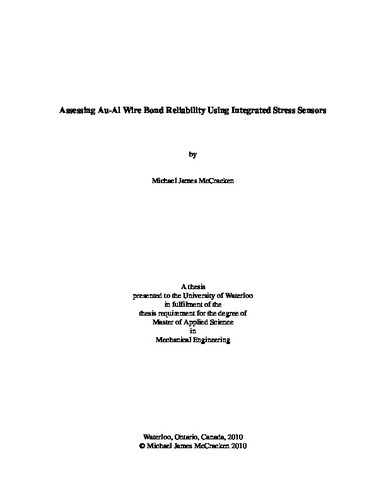| dc.description.abstract | Wire bond reliability testing typically consists of aging bonds in a high temperature environment for long time periods, and removing samples at intervals to assess bond shear strength and characterize the bond cross sections. In this way, the degradation of the bond can be monitored at discrete time intervals, and it is determined whether the bond will be reliable during the specific service life. This process can be labour and time intensive. An alternative method is reported using an existing test chip that allows for contact resistance measurements and provides signals from piezoresistive integrated CMOS microsensors located around test bond pads. The sensors are sensitive to radial compressive or tensile stresses occurring on the bond pad due to intermetallic formation, oxidation, and crack formation at the bond interface. Two sets of identical test chips are bonded with optimized Au ball bonds and aged for 2000 h at 175 ºC. One set is connected to equipment which monitors signals from the stress sensors and the contact resistance of the bonds. The other set is destructively tested by shear tests and cross sectioning. It is found that the stress sensors are capable of indicating which stage of bond aging is experienced by relating the signal to the relative density of the intermetallic compounds (IMCs) and oxide which form during aging.
This research offers a valuable new method for accelerating bond process development. By using the sensors to determine the stage of aging experienced and the magnitude of changes happening to the bond, the initial bond quality and bond reliability can be roughly characterized. A useful application is in comparing large samples of bonds made under varying conditions, and determining relative reliabilities of the bonds. A small sample size is required, as the sensors allow for complete continuous aging histories of individual bonds, which was not previously possible.
A new test chip is designed for use in future studies which allows for contact resistance measurement, and provides stress signals for up to 55 bonds. A multiplexer integrated on the chip allows for measurements from one specified bond pad at a time. The chip is also equipped with x and yforce measurements which can be used to monitor bond process, and a resistive temperature detector for temperature measurement.
A miniaturized bond aging system is designed to facilitate future works where chips are subject to high temperature storage. A heating element fits over the cavity of a microelectronic package containing the test chip, and allows for precise temperature control, while using less power than a conventional oven, and maintaining a low temperature at electrical connections to the package. | en |

